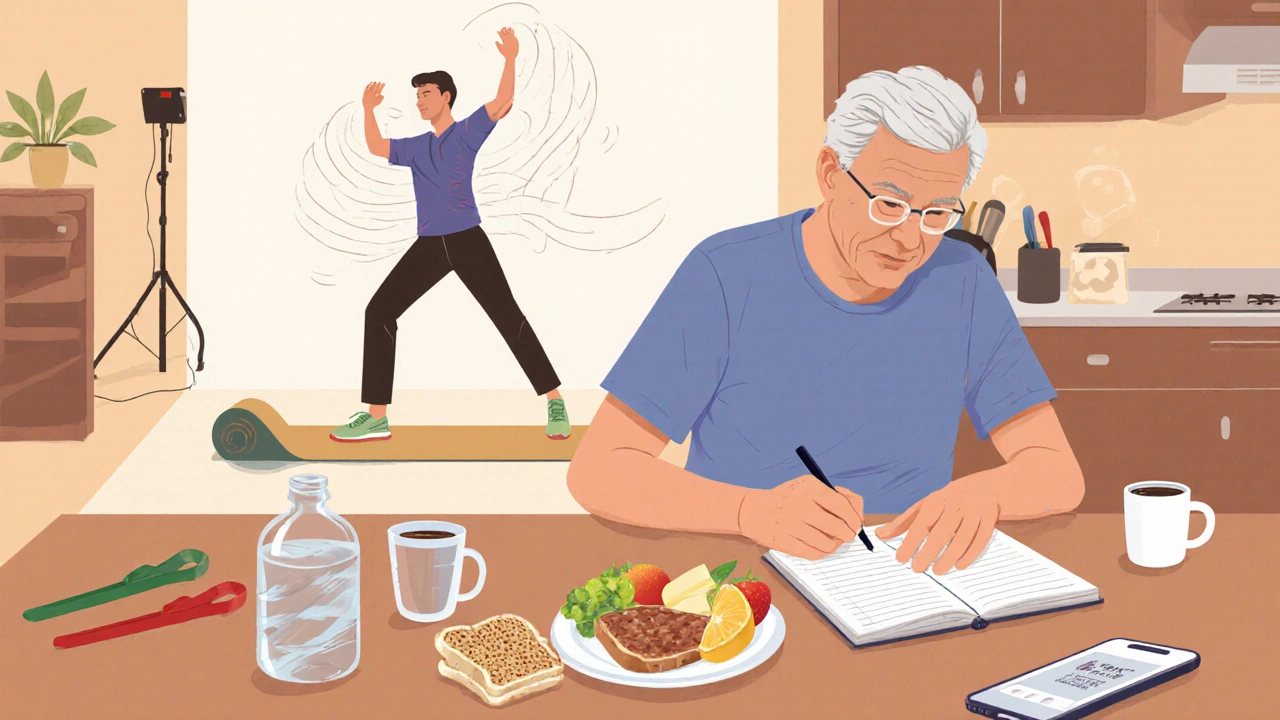Living with Dyskinesia: Practical Tips to Manage Symptoms

Dyskinesia Trigger Identifier
Identify Your Personal Triggers
Answer the following questions to discover potential factors that may be contributing to your dyskinesia symptoms.
Your Potential Dyskinesia Triggers
Personalized Management Plan
Living with dyskinesia can feel like trying to keep a wobbling bike upright while the road keeps shifting. The involuntary movements that define dyskinesia often appear as a side‑effect of Parkinson’s medication, and they can invade daily life in unpredictable ways. The good news? There are dozens of practical steps you can take right now to soften the swing and reclaim a steadier routine.
- Identify personal triggers - timing of meds, stress, caffeine, or lack of sleep.
- Work with your neurologist to fine‑tune medication doses or add adjunct drugs.
- Integrate targeted exercise and stretching to improve motor control.
- Adopt dietary habits that support steady dopamine levels.
- Use therapy tools - physical, occupational, or speech - to maintain function and confidence.
What is Dyskinesia?
Dyskinesia is a movement disorder characterized by involuntary, often jerky or writhing motions that typically arise as a side‑effect of long‑term Parkinson’s disease treatment. Though it can affect the face, limbs, or torso, the intensity varies from subtle twitches to full‑body shaking.
The Link to Parkinson’s Disease
Most people with dyskinesia also have Parkinson's disease, a neurodegenerative condition where dopamine‑producing cells in the brain gradually die. As dopamine levels fall, patients rely on medications like Levodopa to restore movement. Over time, the brain’s response to Levodopa can become erratic, leading to the unpredictable bursts of movement we call dyskinesia.
Spotting Triggers and Early Warning Signs
Before you can tame dyskinesia, you need to know what fuels it. Common triggers include:
- High peaks of Levodopa - especially when the dose is taken on an empty stomach.
- Stress or anxiety - emotional spikes can amplify motor output.
- Caffeine or sugary drinks - these may increase dopamine turnover.
- Lack of sleep - fatigue reduces the brain’s ability to regulate movement.
Keep a simple log for a week: note medication timing, food, stress events, and any noticeable movement changes. Patterns will emerge, giving you concrete data to discuss with your doctor.

Medication Strategies
Adjusting the drug regimen is often the first line of defense. Your neurologist might suggest:
- Splitting a large Levodopa dose into smaller, more frequent doses.
- Adding a dopamine‑agonist such as pramipexole to smooth out peaks.
- Introducing a COMT inhibitor (e.g., entacapone) to prolong Levodopa’s effect.
- Trying a controlled‑release formulation that delivers medication more evenly.
Below is a quick comparison of the most common medication‑based approaches.
| Approach | How It Helps | Typical Effect on Dyskinesia | Key Considerations |
|---|---|---|---|
| Split‑dose Levodopa | Flattens plasma peaks, reducing sudden dopamine spikes | Modest reduction (10‑20%) in peak‑dose dyskinesia | Requires strict timing; may increase pill burden |
| Adjunct Dopamine‑Agonist | Provides steady dopaminergic stimulation | Can cut dyskinesia by up to 30% in some patients | Potential side‑effects: nausea, sleepiness, impulse control issues |
| COMT Inhibitor (e.g., entacapone) | Slows Levodopa breakdown, extending its benefit | Improves motor fluctuations; indirect effect on dyskinesia | May cause diarrhea, urine discoloration |
| Controlled‑Release Levodopa | Delivers drug gradually over several hours | Reduces peak‑dose dyskinesia for many users | Slower onset; not ideal for “off” episodes |
Beyond Pills: Lifestyle Adjustments
Medication tweaks are powerful, but everyday habits can amplify or dampen dyskinesia. Here are three pillars you can build on.
Exercise and Targeted Stretching
Regular movement helps the brain relearn smoother motor patterns. Activities that work on coordination rather than raw strength are especially useful:
- TaiChi - slow, flowing motions improve balance and reduce involuntary jerks.
- Yoga - focused breathing plus gentle postures calm the nervous system.
- Resistance band routines - low‑impact strength work maintains muscle tone without triggering spikes.
Start with 10‑minute sessions three times a week, then gradually increase duration as you feel comfortable.
Dietary Tweaks
What you eat influences dopamine synthesis and medication absorption. Aim for:
- Balanced protein distribution - spread protein across meals instead of a single heavy serving, as high protein can compete with Levodopa absorption.
- Complex carbs (whole grains, oats) - they help maintain steady blood sugar, preventing stress‑related spikes.
- Hydration - dehydration can worsen muscle rigidity, making dyskinesia feel more pronounced.
Some patients notice that limiting caffeine after 2p.m. reduces afternoon tremors, but the effect varies individually.
Sleep Hygiene
Quality sleep restores the brain’s regulatory circuits. Follow these basics:
- Stick to a consistent bedtime and wake‑time, even on weekends.
- Avoid screens for at least 30minutes before bed.
- Keep the bedroom cool (around 18‑19°C) and dark.
If you struggle with insomnia, discuss melatonin or low‑dose clonazepam with your doctor; both can be safe adjuncts when used short‑term.
Therapeutic Options Beyond Medication
If medicines and lifestyle tweaks aren’t enough, several therapies can target dyskinesia directly.
Physical Therapy
Certified Physical Therapy (PT) specialists design personalized movement plans that focus on gait training, balance, and fine‑motor control. Regular PT sessions have been shown to cut dyskinesia severity by about 15% in clinical trials, mainly by reinforcing proper muscle activation patterns.
Occupational Therapy
Occupational Therapy (OT) helps you adapt daily tasks - think larger‑handle utensils, voice‑activated technology, or arranging furniture for smoother navigation. OT also teaches strategies to pause and reset during a dyskinesia episode, reducing falls and frustration.
Speech and Swallowing Therapy
When dyskinesia involves facial muscles, speech can become slurred. Speech‑language pathologists work on breath control and articulation drills that keep the mouth muscles coordinated, which can modestly lessen facial twitching.
Deep Brain Stimulation (DBS)
For patients with severe, medication‑refractory dyskinesia, Deep Brain Stimulation offers a surgical option. Electrodes placed in the subthalamic nucleus or globus pallidus send adjustable electrical pulses that smooth out motor output. Studies from 2022‑2024 show that DBS can reduce dyskinesia severity by up to 60% and also lessen the required Levodopa dose, creating a virtuous cycle.
DBS isn’t a first‑line treatment - it requires thorough evaluation, neuro‑imaging, and a multidisciplinary team. However, for the right candidate, it can be life‑changing.

Coping with the Emotional Side‑Effects
Living with involuntary movements can be mentally exhausting. Anxiety, embarrassment, and depression are common companions. Here are ways to keep the mind as steady as the body:
- Join a local or online support group - sharing experiences normalizes the condition and uncovers new coping tricks.
- Practice mindfulness meditation - even five minutes a day lowers stress hormones that can trigger dyskinesia.
- Consider counseling or CBT - trained therapists can reframe negative thoughts and teach relaxation techniques.
Remember, seeking help for mental health is as vital as adjusting your Levodopa dose.
When to Call Your Neurologist
Not all changes need a doctor’s office, but certain red flags warrant immediate contact:
- Sudden, severe worsening of dyskinesia that interferes with eating or dressing.
- Frequent falls or loss of balance despite therapy.
- New onset of hallucinations or severe mood swings after a medication change.
- Any sign of infection around a DBS implant site (redness, swelling, fever).
Having a clear action plan reduces panic and ensures timely interventions.
Putting It All Together: A Sample Weekly Plan
Below is an example of how you might blend medication, movement, and self‑care in a single week. Feel free to swap activities based on personal preference.
- Monday‑Wednesday‑Friday: Split‑dose Levodopa (morning, midday, early evening). Add 0.5mg pramipexole at breakfast.
- Daily: 10‑minute TaiChi before breakfast; 20‑minute walk after lunch.
- Tuesday & Thursday: Physical therapy session focusing on gait and balance.
- Saturday: Light yoga session + meal‑prep for low‑protein, high‑complex‑carb meals.
- Sunday: Review medication log, note any triggers, and relax with mindfulness meditation.
Tracking progress weekly helps you see what works and where adjustments are needed.
Frequently Asked Questions
Can diet really affect dyskinesia?
Yes. Protein competes with Levodopa absorption, so spreading protein across meals can smooth out dopamine peaks. Consistent carbs and proper hydration also help keep the nervous system stable, reducing the intensity of involuntary movements.
Is deep brain stimulation safe for older adults?
DBS is generally offered to patients who are medically stable and can tolerate surgery, regardless of age. Studies show similar symptom‑reduction benefits in patients over 70, provided they undergo thorough pre‑operative assessment and have solid post‑op support.
How soon after changing medication can I notice a difference?
Most patients notice a shift within a few days to one week, as the body adjusts to new dosing schedules. Keep a symptom journal during this period to capture subtle improvements or emerging side‑effects.
Are there any home‑exercise apps tailored for dyskinesia?
While no app is exclusively for dyskinesia, many Parkinson’s‑focused platforms (e.g., Parkinson’s Exercise Coach, My Parkinson’s Trainer) offer low‑impact routines like TaiChi and balance drills that are safe for people with involuntary movements.
Should I stop caffeine completely?
Not necessarily. Many individuals tolerate a moderate cup of coffee in the morning without issues. If you notice a correlation between caffeine intake and heightened dyskinesia, try cutting back or limiting it to early hours.






Comments (4)
Roxanne Porter
8 Oct 2025
Thank you for compiling such a comprehensive guide on dyskinesia management. The emphasis on individualized trigger identification aligns well with best clinical practice. Integrating regular symptom logs can indeed empower patients during consultations. It is also prudent to remind readers to discuss any medication adjustments with their neurologist before implementation. Ultimately, a collaborative approach between patient and provider yields the most sustainable outcomes.
Jonathan Mbulakey
28 Oct 2025
Reading through the article feels like taking a step back to reflect on how we often accept medication side‑effects as inevitable. The suggestion to split levodopa doses reminds me that small logistical changes can shift the whole experience. It’s interesting how stress, caffeine, and sleep weave together into a pattern that many overlook. Keeping a simple diary might be the quietest yet most powerful tool we have.
Warren Neufeld
17 Nov 2025
I appreciate how the article breaks down dyskinesia into manageable sections. When I first heard the term, I thought it was something you could not control at all. Over time I learned that tracking when symptoms happen makes a big difference. For example, noting that tremors spike after my morning coffee helped me adjust intake. I also discovered that a short walk before medication can smooth the dopamine rise. The suggestion to keep a weekly log is something I now do every Sunday night. Writing down medication times, meals, stress events, and sleep quality creates a clear picture. My neurologist was able to see that my peaks often coincided with late‑day caffeine, so we reduced it after 2 p.m. My dyskinesia episodes have become less intense. I also added a brief Tai Chi routine in the afternoon, which seems to calm my nervous system. Simple breathing exercises before stressful meetings have reduced the jittery feeling that sometimes precedes a flare‑up. Hydration matters too; I make sure to drink at least eight glasses of water daily. When I slipped on a carpet because I was distracted by sudden movements, I realized how important balance training is. Physical therapy sessions focusing on gait have improved my confidence. Monitoring sleep patterns revealed that occasional insomnia was aggravating my symptoms, so I introduced a consistent bedtime routine. The combination of medication tweaks, exercise, and mindful habits has turned a chaotic experience into a more predictable one. I encourage anyone dealing with dyskinesia to start with a symptom journal and share it with their care team; the empowerment it brings is invaluable.
Patrick McGonigle
7 Dec 2025
The pharmacological options outlined here are consistent with current guidelines. Splitting levodopa doses can attenuate plasma peaks that trigger dyskinesia. Adding a dopamine‑agonist such as pramipexole may provide smoother dopaminergic stimulation. COMT inhibitors like entacapone extend levodopa’s half‑life, which can be useful for some patients. Controlled‑release formulations are another avenue to explore when timing flexibility is needed.